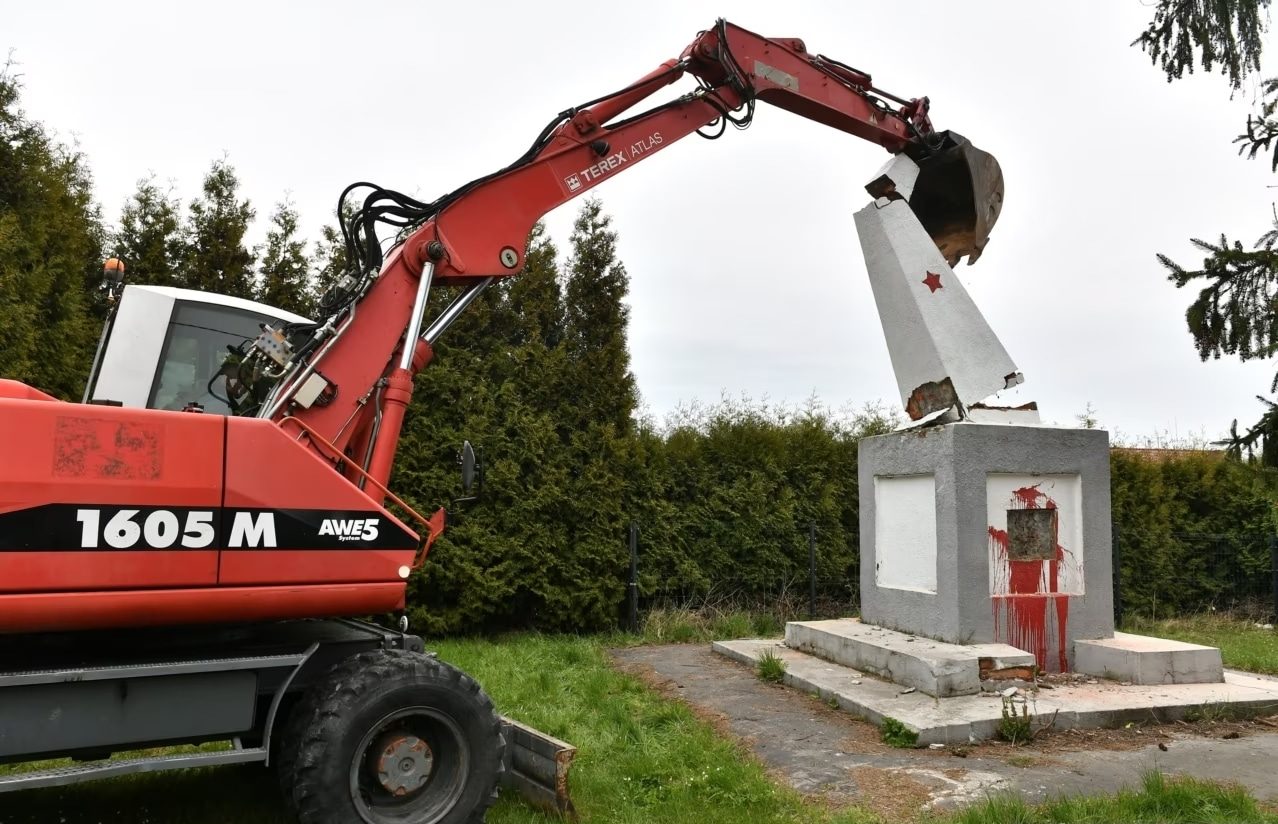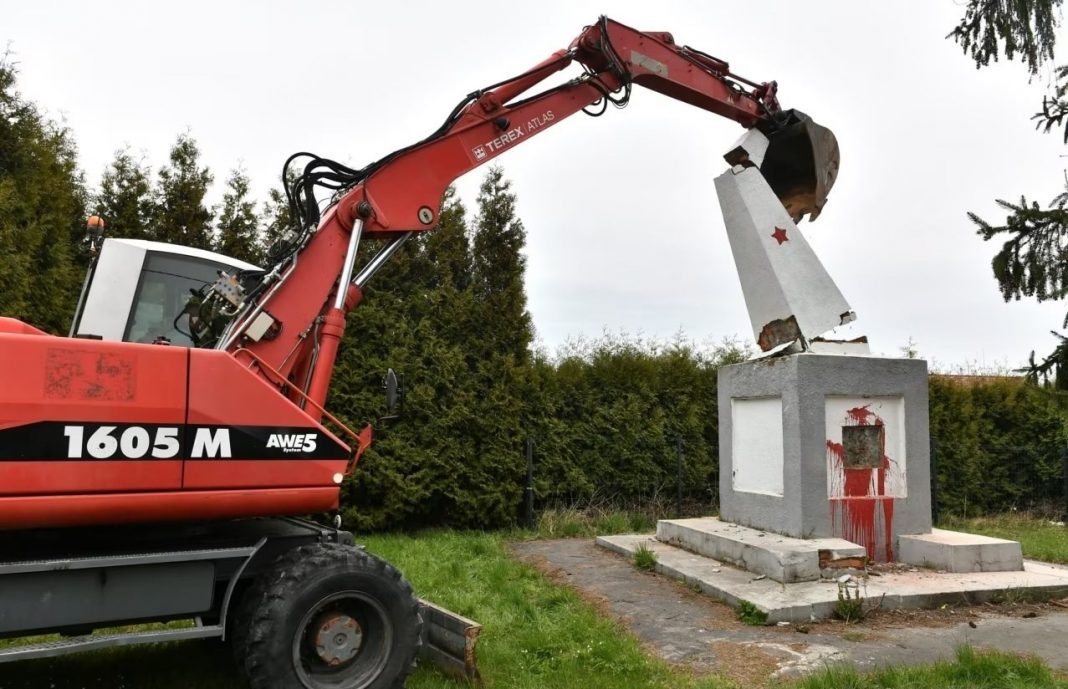
Friday, July 7, 2023 – 11:05 (EEST) Section: Analysis & Opinion, International, Latest news
With the beginning of the full-scale Russian invasion of Ukraine, former Soviet countries initiated a new phase of decommunization and derussification. Thus, the removal of Russian monuments applies to both the “Leninfall” and the “Pushkinfall.” Chytomo (Ukrainian media outlet) collected the following cases.
Estonia
When discussing the Baltic countries, it is worth mentioning one of the possible approaches to unwanted monuments of the past — not their removal from the public space but reevaluation.
Monuments often become centers of memory conflicts since the significance of monuments can change in both political and social contexts. The Baltic countries experienced three waves of work with monuments created during the Soviet occupation: in the 1990s, the 2000s, and since 2022. In the 1990s, there was a period of toppling Lenin statues, but in the 2000s, a new approach of reinterpretation, reemphasis, and reevaluation of Soviet-era monuments emerged. Instead of getting rid of reminders of a specific historical period, this approach involves changing the meaning of monuments and thus working with memory itself. Therefore, the monuments remained as they were, but the context changed.
An example can be the monument of Vladimir Lenin in Estonia. The Lenin Memorial (sculptor Olav Männi) was ceremoniously unveiled on November 7, 1957, in Peetri Square, but it was dismantled in 1993. Since then, the Lenin monument was kept in the auxiliary collection of the Narva Muuseum.
At the end of 2022, the monument was transported from the Narva fortress to the Estonian History Museum. There, an open-air exhibition of Soviet-era monuments is held. Until spring 2023, the monument was stored in the War Museum, where appropriate premises were available for this purpose.
In November 2022, a special working group at the State Chancellery recommended demolishing or replacing 244 out of 322 Soviet monuments on the territory of the country. Other 74 Soviet monuments were considered neutral.
By February 2023, the Riigikogu (the Parliament of Estonia) adopted amendments to the Building Code and the Law on State Property, which regulate the dismantling of Soviet monuments. Previously, the removal and relocation of monuments required action based on general legal and criminal norms. Currently, these procedures are stipulated in the rules of the construction industry.
“The publicly accessible part of a building, as well as a publicly displayed monument, sculpture, memorial, or other object, should not incite hatred, support, or justify an occupation regime, acts of aggression, genocide, crimes against humanity, or war crimes,” the amendments state.
However, with the onset of a new phase of the Russian-Ukrainian war, the Baltic countries partially abandoned the idea of reinterpretation, and Soviet monuments began to disappear from public spaces.
Latvia
On June 16, 2022, the Latvian Parliament (Saeima) adopted the law On the Prohibition of the Display and Dismantling of Objects Glorifying the Soviet and Nazi Regimes in the Republic of Latvia. The law stipulates the demolition of objects that glorify totalitarian regimes by November 15 of the same year. Thanks to this law, in November of last year, the monument to the Soviet soldier “Alyosha” was dismantled in Rezekne. It was one of the last remaining large monuments from the Soviet era in Latvia.
According to the same law, in August, a Soviet monument in Victory Park was dismantled in Riga, and in October, another one was removed in Daugavpils.
One of the most recent cases of dismantling, which reflects not only the decommunization of previously occupied countries but also decolonization, was the removal of the sculpture of Russian poet Alexander Pushkin from Kronvalds Park in Riga. The sculpture was relocated over 13 years after its installation. Throughout this time, it had been unlawfully in place. In 2009, the Riga Historic Centre Preservation and Development Council and the State Inspection for Heritage Protection disagreed with the placement of the sculpture in Kronvalds Park.
“The dismantling of evidence of the totalitarian regime and signs of russification should be accelerated now, without making this process a subject of potential provocations,” said Dīdžis Šēnbergs, a member of the Public Memory Center.
The sculpture will be transferred to the Latvian Artists’ Union Museum with whom an agreement has been reached regarding the preservation of the monument and its future exhibition.
As part of the implementation of the same law, in August 2022, a concrete obelisk with Soviet stars was demolished in Riga. It was the central part of the monument commemorating the victory of the Red Army over Nazi Germany.
See also: How Ukrainian museums survive during the great war
Overall, in Latvia, as of November 2022, 120 objects glorifying Soviet power were dismantled. All 69 objects that were subject to demolition according to the government’s decree were dismantled in a timely manner, before November 15. Additionally, municipalities independently demolished 55 objects.
Lithuania
At the Antakalnis Cemetery in Vilnius, one of the largest memorials to Soviet troops in the country was also dismantled. It is worth noting that the municipality of the Lithuanian capital did so despite a resolution by the UN Human Rights Committee on the preservation of sculptures that formally prohibits the removal of these monuments (the issue was brought to the committee by “ethnic Russians” residing in Lithuania). After the start of the dismantling, the Mayor of Vilnius, Remigijus Šimašius, stated that the permit for these works was issued by the municipality, and therefore, there was no need to seek separate clarifications from the UN. The sculptures that were removed were handed over to the National Museum of Lithuania by the local authorities.
In addition, there are plans to rename the Pushkin Museum in Vilnius. The City Council will consider renaming the Alexander Pushkin Literary Museum (the first literary museum in the capital of Lithuania) to the Markučiai Manor Museum.
In 1899, Varvara Pushkina moved to the Markučiai Manor near Vilnius, where she married Grigory Pushkin, the son of poet Alexander Pushkin. After her death and according to her will, the Pushkin Museum was established there in 1940. It was officially opened in 1948.
“According to the will of the last owner of the Markučiai Manor, V. Pushkina, it is evident that the owners did not refer to the manor as ‘Pushkin manor’; it was called the Markučiai Manor,” explained the city council.
The proposed name for the Markučiai Manor has been agreed upon with representatives from the Ministry of Culture, the State Commission of the Lithuanian Language, and the Faculty of History at Vilnius University.
Furthermore, in Lithuania, there is a desire to abandon the teaching of the Russian language in schools.
Poland
Due to the full-scale Russian invasion of Ukraine, the Institute of National Remembrance of Poland (IPN) has revived its initiative for the decommunization of public spaces.
“At the end of World War II, Soviet forces pushed back the German Nazi occupiers in Eastern Europe (which Russia now refers to as ‘liberation’), but many inhabitants of these countries, including Poland, perceive these events as a substitution of one totalitarian regime for another. The Russian invasion of Ukraine is accompanied by the glorification of Russian imperialist traditions and the relativization of the crimes of Soviet communism,” emphasized Karol Nawrocki, the head of the IPN.
According to him, this makes the Polish people even more aware of the importance of removing names and symbols that promote communism from Polish public space.
As part of decommunization, a monument to the Red Army was dismantled in Chrzowice on March 23, 2022, and in April, a monument to the Red Army in Siedlce was dismantled.
On August 24, 2022, a memorial from Soviet times commemorating the Red Army soldiers was dismantled in Poland. It was seen as an unwanted reminder of the power Moscow once had over Poland and a symbol that became even more unacceptable after Russia’s invasion of Ukraine.
The dismantling of the memorial in Brzeg, in the southwest of Poland, coincided with Ukraine’s Independence Day and took place six months after the start of Russia’s full-scale invasion of Ukraine.
Partial list of dismantled Russian monuments in Latvia, Estonia, Lithuania, Finland, and Poland during 2022:
- On April 22, in Mariampol, Lithuania, a monument to Soviet soldiers was dismantled.
- On April 26, the sculpture “Soldier” was removed from a Soviet cemetery in Kaunas, Lithuania.
- On April 26, in the Latvian village of Madliena, a monument to Red Army soldiers was dismantled.
- On April 27, a sculpture of a Soviet soldier was dismantled at Kėdainiai Cemetery in Lithuania.
- On May 19, a Soviet obelisk was demolished in Palanga, Lithuania.
- On May 20, a monument to Soviet soldiers was demolished in Merkinė, Lithuania.
- On July 5, a monument to Soviet liberating soldiers was dismantled in the Lithuanian city of Klaipėda.
- On August 7, a monument to the builders of the Narva Power Plant was dismantled in Estonia.
- On August 8, the dismantling of the sculpture “Peace in the Whole World” began in Helsinki, Finland. The sculpture was gifted to the city by Moscow in 1990.
- On August 16, a monument to Soviet Army officer Igor Grafov was dismantled in Narva, Estonia.
- On August 16, memorial plaques were removed from Petrovskaya Square in Narva, Estonia.
- On August 16, a monument called “Three Bayonets” was dismantled in Narva.
- On August 16, a T-34 tank was disassembled in Narva, Estonia.
- On August 25, a monument to the liberators of Riga was demolished in Latvia.
Originally posted by Olesia Boyko on Chytomo. Translated and edited by the UaPosition – Ukrainian news and analytics website






